Durability of Concrete with Superabsorbent Polymer (SAP) Assessed Using Depth of Carbonation and NDT Ultrasonic Methods
Abstract
:1. Introduction
2. Materials and Methods
2.1. Materials and Their Characterization
- Aggregate including Vistula River sand and natural gravels of fractions 2/4 mm, 4/8 mm, and 8/16 mm (meeting the requirements of the PN-EN 12620+A1:2010 standard [26] with Polish national appendix);
- Tap water (meeting the requirements of the EN 1008:2002 standard [27]);
- Superplasticizing commercial admixture (according to the manufacturer: based on modified polycarboxylates and phosphonates).
2.2. Concretes with SAP Subjected to Carbonation Testing and NDT
- concrete with 100% mixing water in a traditional liquid form, no water bond in the form of SAP hydrogel—marked as OC (ordinary concrete);
- concrete with 25% of water bond in SAP (75% in liquid form)—marked as SAP-25;
- concrete with 50% of water bond in SAP (50% in liquid form)—marked as SAP-50;
- concrete with 50% of water bond in SAP (50% in liquid form)—marked as SAP-50s;
- concrete with 75% of water bond in SAP (25% in liquid form)—marked as SAP-75.
2.3. Methods
2.3.1. Concrete Mix Testing Methods
2.3.2. Carbonation Testing Method
2.3.3. Non-Destructive Testing (NDT)
- Tests were conducted using a piezoelectric transducer of a frequency of 100 kHz;
- Values of transit time were recorded for specimens of similar thickness: ca. 100 mm, being the dimension of the tested concrete cubes (measured with an accuracy of 0.01 mm);
- Transit time measurements formed the basis for calculating the ultrasonic wave velocity, which was expressed in m/s (with an accuracy of 1 m/s);
3. Results and Discussion
3.1. Concrete Mix Testing Results
3.2. Carbonation Testing Results
- The fastest progress of carbonation noted for OC occurred between the 28th and 56th day of the test (at other times, the depth of carbonation increased more slowly);
- In case of concretes with SAP a reverse tendency was noted: the test period between 14th and 28th day characterized by the highest carbonation development rate.


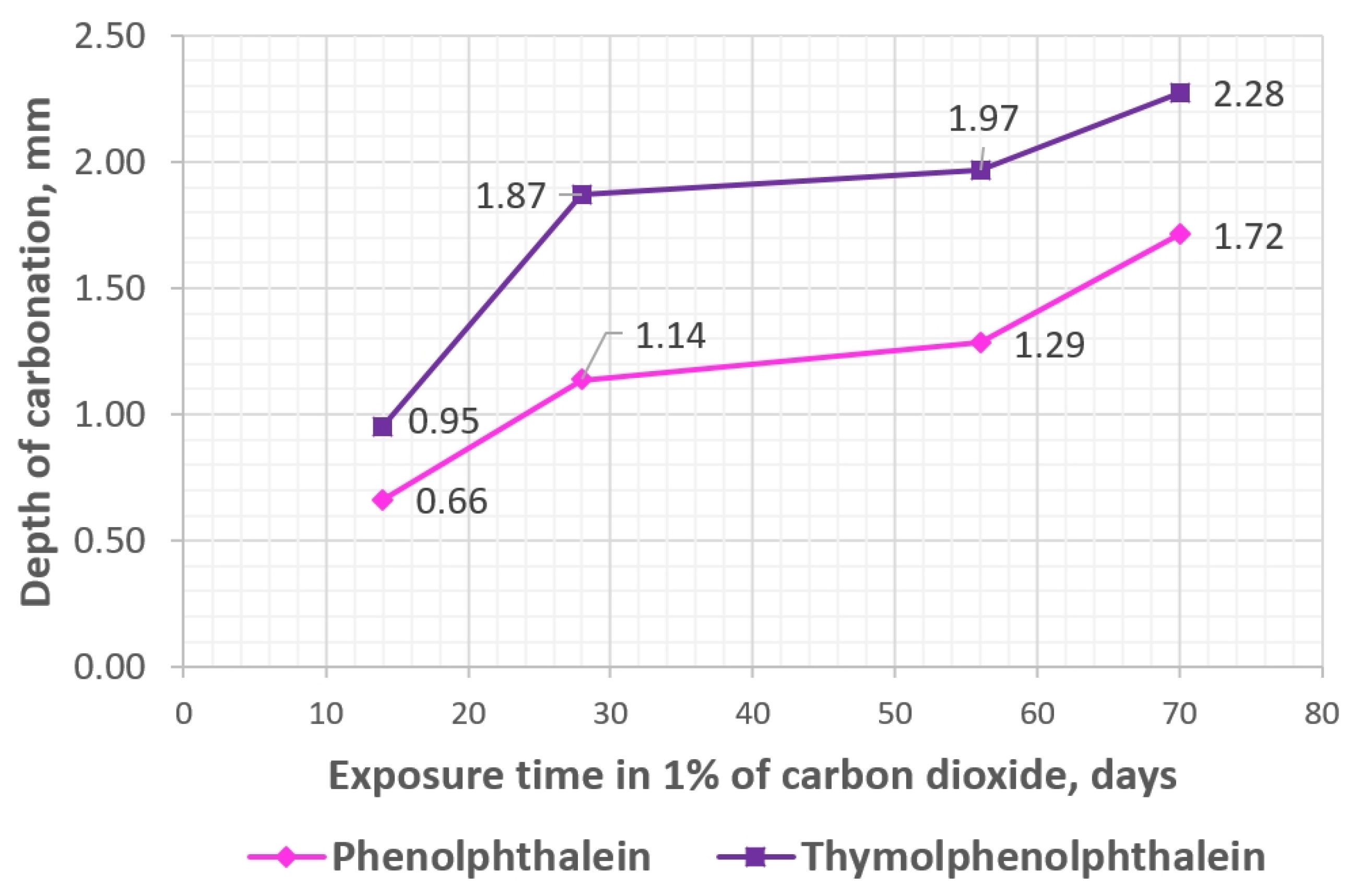
3.3. NDT Testing Results
4. Conclusions
- Introducing mixing water to the concrete mix in the form of pre-saturated superabsorbent polymer hydrogel (in the analyzed range, i.e., up to 75% of water) did not affect the density of the concrete mix, yet it changed the consistency. However, the unequivocal relation between the concrete consistency measured with the slump test method and the SAP hydrogel content cannot be determined.
- The influence of the superplasticizer on the SAP water absorption capacity was found. What is more, the method of introducing the superplasticizer into the concrete mix (together with SAP hydrogel or together with remaining traditional liquid mixing water) turned out to be important in the context of concrete properties.
- The obtained results showed a slight effect of introducing the superabsorbent polymer into the concrete mix on the concrete carbonation, which stands in line with the results obtained in other experiments. The greater depth of carbonation of concretes with SAP may be the result of the gradual water desorption from SAP particles, the formation of a pore network, and their influence on the increased diffusion of CO2 into the concrete structure.
- The applied non-destructive ultrasonic method has proved to be a sufficient and convenient tool to assess the changes in homogeneity of concrete with SAP.
- It was possible to elaborate a relation between the age of concrete modified with SAP and the densification of its microstructure resulting from the progressive internal curing. The NDT testing showed that, regardless of the direction of the ultrasonic pulse movement, very similar results of its pulse velocity were obtained within one concrete type (low CV values ranging from 0.8% to 2.3%). This proves the high degree of homogeneity of the structure of the tested concretes containing SAP.
- After 28 days of curing, the UPV values varied depending on the content of water introduced into the concrete mix in the form of SAP hydrogel, showing the general tendency that the more hydrogel, the lower the velocity. After the next 3 years, however, the values of velocity increased, confirming that the SAP did not retain water and that the later hydration performed correctly.
Funding
Institutional Review Board Statement
Informed Consent Statement
Data Availability Statement
Acknowledgments
Conflicts of Interest
References
- Shoaei, P.; Ghassemi, P.; Ameri, F.; Musaeei, H.R.; Ban, C.C.; Ozbakkaloglu, T. Comparative study on the effect of fiber type and content on the fire resistance of alkali-activated slag composites. Constr. Build. Mater. 2021, 288, 123136. [Google Scholar] [CrossRef]
- Alyousef, R.; Ali, B.; Mohammed, A.; Kurda, R.; Alabduljabbar, H.; Riaz, S. Evaluation of Mechanical and Permeability Characteristics of Microfiber-Reinforced Recycled Aggregate Concrete with Different Potential Waste Mineral Admixtures. Materials 2021, 14, 5933. [Google Scholar] [CrossRef]
- Mechtcherine, V.; Reinhardt, H. Application of Superabsorbent Polymers in Concrete Construction: State-of-the-Art Report of the RILEM TC 225-SAP; Springer: Berlin/Heidelberg, Germany, 2012. [Google Scholar]
- Olawuyi, B.J.; Boshoff, W.P. Influence of SAP content and curing age on air void distribution of high performance concrete using 3D volume analysis. Constr. Build. Mater. 2017, 135, 580–589. [Google Scholar] [CrossRef]
- Sikora, K.; Klemm, A. The effect of superabsorbent polymers on performance of fly ash cementitious mortars exposed to accelerated freezing/thawing conditions. J. Comput. Methods Exp. Meas. CMEM 2013, 3, 255–268. [Google Scholar] [CrossRef]
- Almeida, F.C.R.; Klemm, A.J. Efficiency of internal curing by superabsorbent polymers (SAP) in PC-GGBS mortars. Cem. Concr. Comp. 2018, 88, 41–51. [Google Scholar] [CrossRef]
- He, Z.; Shen, A.; Guo, Y.; Lyu, Z.; Li, D.; Qin, X.; Zhao, M.; Wang, Z. Cement-based materials modified with superabsorbent polymers: A review. Constr. Build. Mater. 2019, 225, 569–590. [Google Scholar] [CrossRef]
- Kim, I.-S.; Choi, S.-Y.; Choi, Y.-S.; Yang, E.-I. Effect of Internal Pores Formed by a Superabsorbent Polymer on Durability and Drying Shrinkage of Concrete Specimens. Materials 2021, 14, 5199. [Google Scholar] [CrossRef]
- Jeon, S.-I.; Jung, D.-H.; Nam, J.-H.; Nho, J.-M. Strength Development and Shrinkage of Superabsorbent Polymer Concrete with Calcium Sulfoaluminate Clinker and Shrinkage Reducing Admixture. Sustainability 2021, 13, 8362. [Google Scholar] [CrossRef]
- Snoeck, D.; Velasco, L.F.; Mignon, A.; Van Vlierberghe, S.; Dubruel, P.; Lodewyckx, P.; De Belie, N. The effects of superabsorbent polymers on the microstructure of cementitious materials studied by means of sorption experiments. Cem. Con. Res. 2015, 77, 26–35. [Google Scholar] [CrossRef]
- Woyciechowski, P.P.; Kalinowski, M. The Influence of Dosing Method and Material Characteristics of Superabsorbent Polymers (SAP) on the Effectiveness of the Concrete Internal Curing. Materials 2018, 11, 1600. [Google Scholar] [CrossRef] [PubMed]
- Kalinowski, M.; Woyciechowski, P.; Sokołowska, J.J. Effect of mechanically-induced fragmentation of polyacrylic superabsorbent polymer (SAP) hydrogel on the properties of cement composites. Constr. Build. Mater. 2020, 263, 120135. [Google Scholar] [CrossRef]
- Czarnecki, L.; Geryło, R.; Kuczyński, K. Concrete Repair Durability. Materials 2020, 13, 4535. [Google Scholar] [CrossRef] [PubMed]
- Zohuriaan-Mehr, M.J.; Kabiri, K. Superabsorbent Polymer Materials: A Review. Iran. Polym. J. 2008, 17, 451–477. [Google Scholar]
- Mignon, A.; Snoeck, D.; Dubruel, P.; Van Vlierberghe, S.; De Belie, N. Crack Mitigation in Concrete: Superabsorbent Polymers as Key to Success? Materials 2017, 10, 237. [Google Scholar] [CrossRef]
- Mignon, A.; Graulus, G.-J.; Snoeck, D.; Martins, J.; De Belie, N.; Dubruel, P.; Vlierberghe, S.V. pH-Sensitive superabsorbent polymers: A potential candidate material for self-healing concrete. J. Mater. Sci. 2015, 50, 970–979. [Google Scholar] [CrossRef]
- Călina, I.; Demeter, M.; Scărișoreanu, A.; Micutz, M. Development of Novel Superabsorbent Hybrid Hydrogels by E-Beam Crosslinking. Gels 2021, 7, 189. [Google Scholar] [CrossRef]
- Jamroży, Z. Beton i Jego Technologie; Wydawnictwo Naukowe PWN: Warszawa-Kraków, Poland, 2000. [Google Scholar]
- Czarnecki, L. Polymer concretes. Cem. Lime Concr. 2010, 15, 63–85. [Google Scholar]
- Łukowski, P.; Dębska, D. Effect of Polymer Addition on Performance of Portland Cement Mortar Exposed to Sulphate Attack. Materials 2020, 13, 71. [Google Scholar] [CrossRef]
- Mönnig, S. Superabsorbing Additions in Concrete—Applications, Modelling and Comparison of Different Internal Water Sources. Ph.D. Thesis, University of Stuttgart, Stuttgart, Germany, 2009; p. 164. [Google Scholar]
- Sikora, K.; Klemm, A.J. Freeze/thaw performance of polymer modified cementitious mortars exposed to NaCl solution. Restor. Build Monum. 2012, 18, 1–8. [Google Scholar] [CrossRef]
- Hasholt, M.T.; Jensen, O.M.; Laustsen, S. Superabsorbent polymers as a means of improving frost resistance of concrete. Adv. Civ. Eng. Mat. 2015, 1, 237–256. [Google Scholar] [CrossRef]
- Mechtcherine, V.; Schröfl, C.; Reichardt, M.; Klemm, A.J.; Khayat, K.H. Recommendations of RILEM TC 260-RSC for using superabsorbent polymers (SAP) for improving freeze—Thaw resistance of cement-based materials. Mater. Struct. 2019, 52, 75. [Google Scholar] [CrossRef]
- EN 197-1:2011; Composition, Specifications and Conformity Criteria for Common Cements. British Standards Institution: London, UK, 2011.
- PN-EN 12620+A1:2010; Aggregates for Concrete. European Standard: Brussels, Belgium, 2010.
- EN 1008:2002; Mixing Water for Concrete—Specification for Sampling, Testing and Assessing the Suitability of Water, Including Water Recovered from Processes in the Concrete Industry, as Mixing Water for Concrete. British Standards Institution: London, UK, 2002.
- Bohren, C.F.; Huffman, D.R. Absorption and Scattering of Light by Small Particles; Wiley-Interscience: New York, NY, USA, 2010. [Google Scholar]
- Ruello, G.; Lattanzi, R. Scattering from Spheres: A New Look into an Old Problem. Electronics 2021, 10, 216. [Google Scholar] [CrossRef] [PubMed]
- Wang, R.; Li, J.; Zhang, T.; Czarnecki, L. Chemical interaction between polymer and cement in polymer-cement concrete. Bull. Pol. Acad. Sci. Tech. Sci. 2016, 64, 785–792. [Google Scholar] [CrossRef]
- Van Gemert, D. Synergies between Polymers and Cement Concrete Providing Opportunities for Sustainable Construction. Adv. Mater. Res. 2013, 687, 12–20. [Google Scholar] [CrossRef]
- Wiliński, D.; Łukowski, P.; Rokicki, G. Polymeric superplasticizers based on polycarboxylates for ready-mixed concrete: Current state of the art. Polimery 2016, 61, 474–481. [Google Scholar] [CrossRef]
- EN 12350-6:2019; Testing Fresh Concrete—Part 6: Density. Swedish Institute for Standards: Stockholm, Sweden, 2019.
- EN 12350-2:2019; Testing Fresh Concrete—Part 2: Slump Test. Swedish Institute for Standards: Stockholm, Sweden, 2019.
- EN 13295:2004; Products and Systems for the Protection and Repair of Concrete Structures—Test Methods—Determination of Resistance to Carbonation. British Standards Institution: London, UK, 2004.
- Woyciechowski, P. Influence of mineral additives on concrete carbonation. In Brittle Matrix Composites 10; Brandt, A.M., Olek, J., Glinicki, M.A., Leung, C.K.Y., Eds.; Woodhead Publishing Limited: Cambridge, MA, USA, 2013; pp. 115–124. [Google Scholar]
- Kalinowski, M.; Woyciechowski, P. Chloride Diffusion in Concrete Modified with Polyacrylic Superabsorbent Polymer (SAP) Hydrogel—The Influence of the Water-to-Cement Ratio and SAP-Entrained Water. Materials 2021, 14, 4064. [Google Scholar] [CrossRef]
- Garbacz, A.; Garboczi, E.J. Ultrasonic Evaluation Methods Applicable to Polymer Concrete Composites; Nist Report nr NISTIR 6975; National Institute of Standards and Technology: Gaithersburg, MD, USA, 2003. [Google Scholar]
- Zalegowski, K.; Piotrowski, T.; Garbacz, A.; Adamczewski, G. Relation between microstructure, technical properties and neutron radiation shielding efficiency of concrete. Constr. Build. Mater. 2020, 235, 117389. [Google Scholar] [CrossRef]
- Diaz, M.; Kilincarslan, S.; Koru, M.; Tuzlak, F. Investigation of Relationships between Ultrasonic Pulse Velocity and Thermal Conductivity Coefficient in Foam Concretes. Acta Phys. Pol. 2016, 130, 469–470. [Google Scholar] [CrossRef]
- Dabbaghi, F.; Sadeghi-Nik, A.; Ali Libre, N.; Nasrollahpour, S. Characterizing fiber reinforced concrete incorporating zeolite and metakaolin as natural pozzolans. Structures 2021, 34, 2617–2627. [Google Scholar] [CrossRef]
- Garbacz, A.; Sokołowska, J.J.; Lutomirski, A.; Courard, L. Fly ash polymer concrete quality assessment using ultrasonic method. In Proceedings of the 7th Asian Symposium on Polymers in Concrete ASPIC 2012, Istanbul, Turkey, 3–5 October 2012; pp. 573–580. [Google Scholar]
- EN 12504-4:2021; Testing Concrete in Structures—Part 4: Determination of Ultrasonic Pulse Velocity. British Standards Institution: London, UK, 2021.
- Garbacz, A. Non-Destructive Investigations of Polymer-Concrete Composites with Stress Waves—Repair Efficiency Evaluation, 1st ed.; Oficyna Wydawnicza Politechniki Warszawskiej: Warsaw, Poland, 2007; pp. 72–73. [Google Scholar]
- Ramezanianpour, A.A.; Mortezaei, M.; Mirvalad, S. Synergic effect of nano-silica and natural pozzolans on transport and mechanical properties of blended cement mortars. J. Build. Eng. 2021, 44, 102667. [Google Scholar] [CrossRef]
- Wang, R.; Shi, X.X.; Wang, P.M. Recent Research on Polymer-Modified Cement Mortar in China. Adv. Mater. Res. 2013, 687, 57–67. [Google Scholar] [CrossRef]
- Woyciechowski, P.; Woliński, P.; Adamczewski, G. Prediction of Carbonation Progress in Concrete Containing Calcareous Fly Ash Co-Binder. Materials 2019, 12, 2665. [Google Scholar] [CrossRef] [PubMed]
- Woyciechowski, P.; Kalinowski, M. The influence of concrete modification with superabsorbent polymers (SAP) on the course of carbonation and mechanical properties. Mater. Bud. 2020, 578, 40–43. [Google Scholar] [CrossRef]
- Woyciechowski, P.; Kalinowski, M. Course of carbonation of concrete internally-cured by means of superabsorbent polymer. In Monografie Technologii Betonu; Stowarzyszenie Producentów Cementu: Kraków, Poland, 2021; pp. 1135–1148. (In Polish) [Google Scholar]
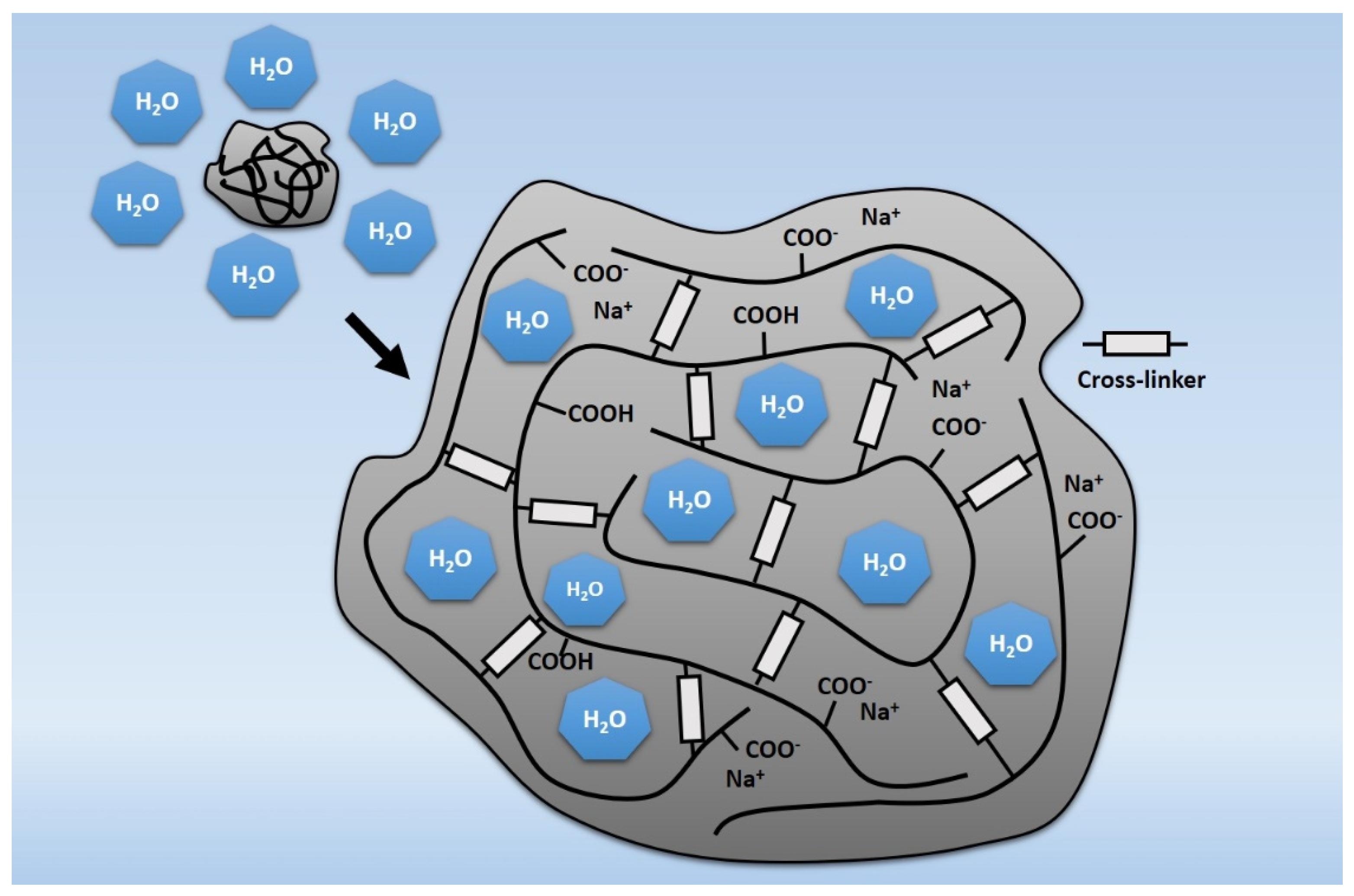
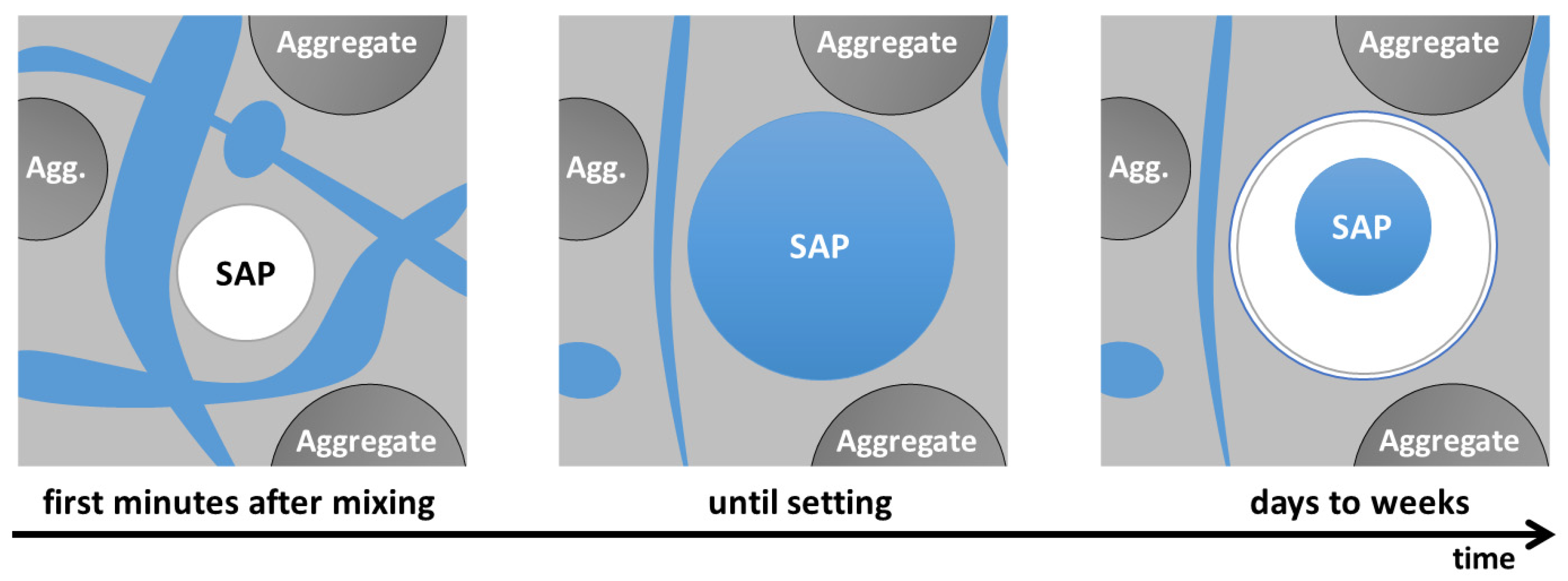
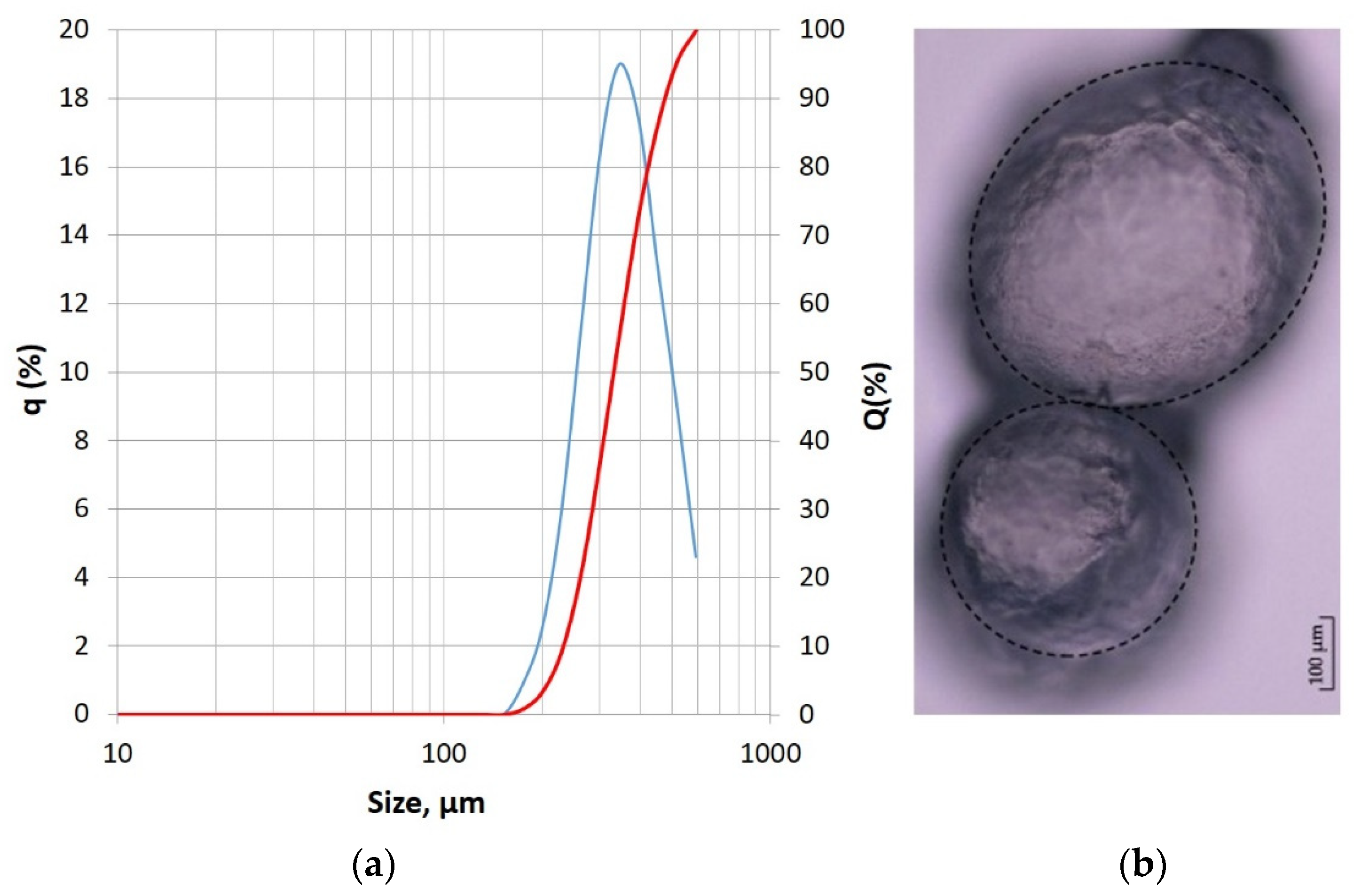
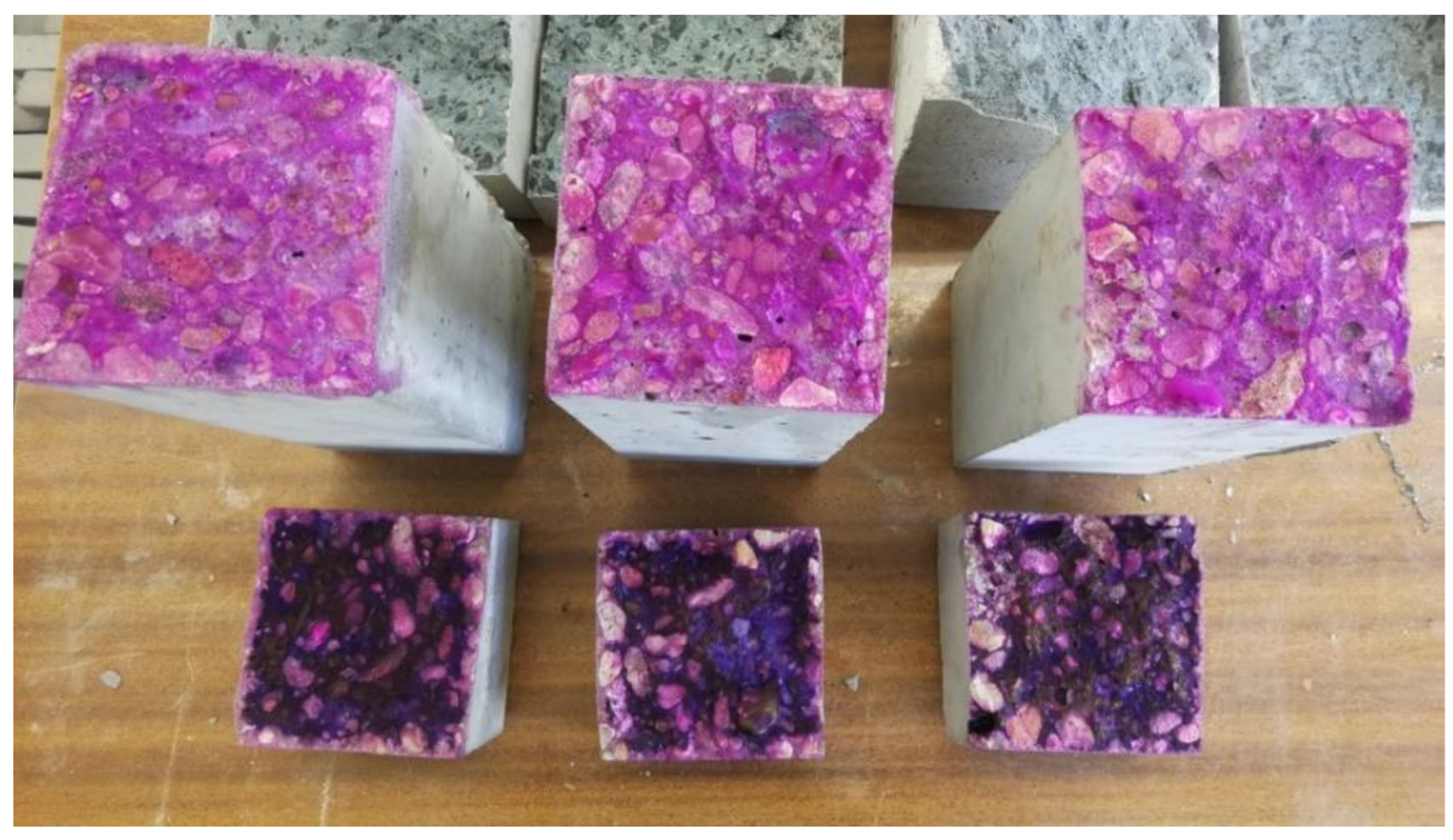

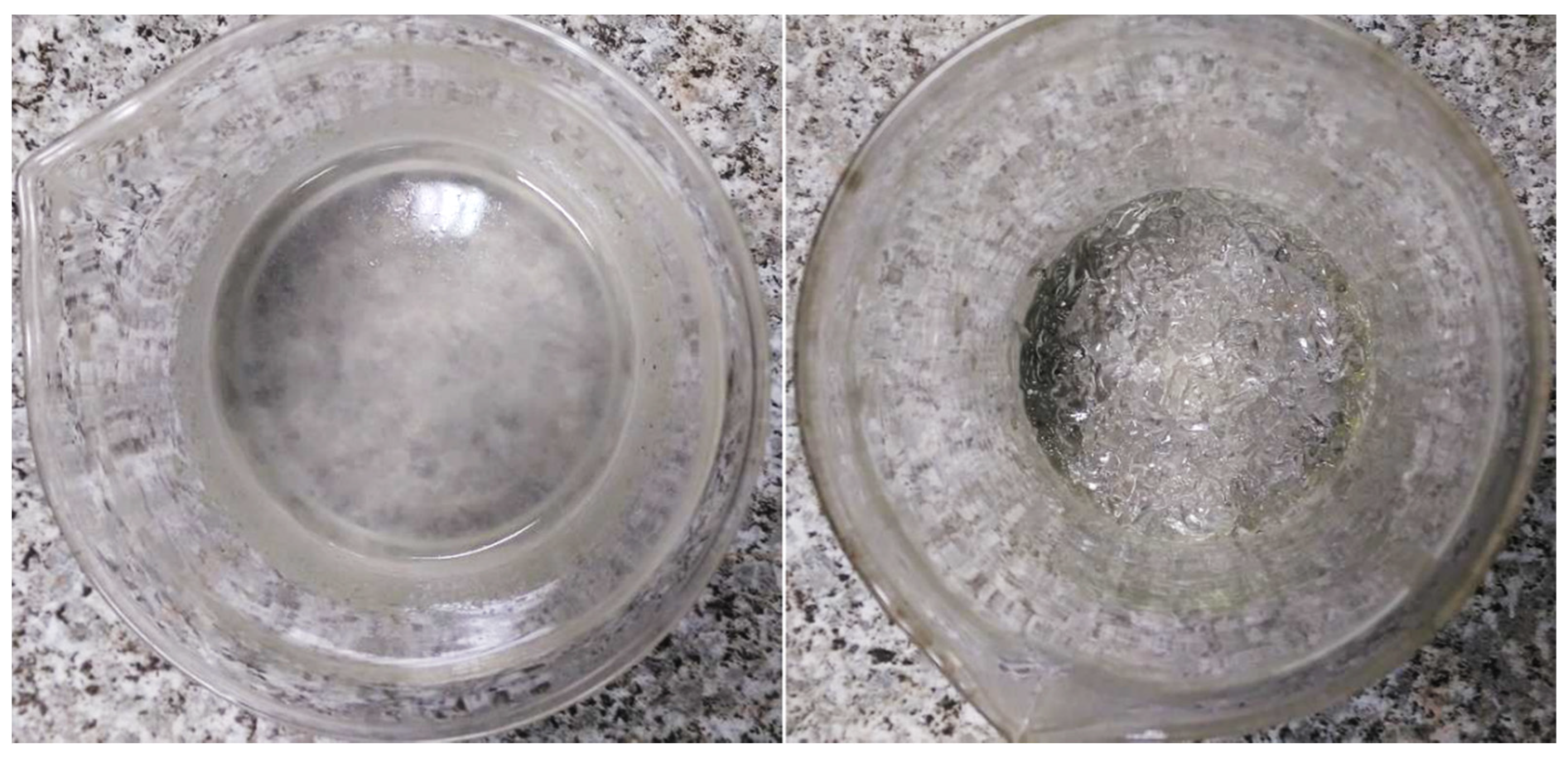

| Characteristic | Information/Value | |
|---|---|---|
| Chemical characteristics 1 | Ignition loss [%] | 3.32 |
| Insoluble residue [%] | 0.70 | |
| Sulphate content SO3 [%] | 3.13 | |
| Chloride content Cl− [%] | 0.05 | |
| Alkali content Na2Oeq [%] | 0.65 | |
| Physical properties | Beginning of setting time [min] | 200 |
| Stability of volume [mm] | 0.00 | |
| Specific surface area [cm2/g] | 4017 | |
| Mechanical properties | Compressive strength after 2 days [MPa] | 28.0 |
| Compressive strength after 28 days [MPa] | 57.0 | |
| Characteristic | Information/Value | |
|---|---|---|
| State of aggregation | Solid (powder) | |
| Color | Colorless, transparent | |
| Density, g/cm3 | 0.300–0.900 | |
| Absorbency with distilled water [g/g] | 300–400 | |
| Solubility | Insoluble in water | |
| Grading 1 | <152 µm | ≤8% |
| 152–750 µm | 86–95% | |
| >750 µm | ≤6% | |
| Concrete Symbol | Properties of Concrete Mix | ||||
|---|---|---|---|---|---|
| Density [kg/m3] | Slump Test, h [mm] | Δh 1 [%] | Consistency Class (Slump Test) | Consistency Class Range [mm] | |
| OC | 2452 | 185 | - | S4 | S4: (160–210) ± 30 |
| SAP-25 | 2422 | 205 | 10.8 | S4 | |
| SAP-50 | 2457 | 225 | 21.6 | S4 | |
| SAP-50s | 2431 | 85 | −54.0 | S3 | S3: (100–150) ± 30 |
| SAP-75 | 2425 | 125 | −32.4 | S3 | |
| Concrete Symbol | Ultrasonic Wave Velocity, cp | ||||||
|---|---|---|---|---|---|---|---|
| After 28 Days | After 3 Years | Change | |||||
| Mean [m/s] | SD [m/s] | CV [%] | Mean [m/s] | SD [m/s] | CV [%] | Δcp [%] | |
| OC | 5070 | 82 | 1.6 | 5020 | 101 | 2.0 | −1.0 |
| SAP-25 | 5047 | 38 | 0.8 | 5152 | 211 | 4.1 | 2.1 |
| SAP-50 | 4947 | 42 | 0.8 | 4958 | 107 | 2.2 | 0.2 |
| SAP-50s | 5043 | 55 | 1.1 | 5475 | 100 | 1.8 | 8.6 |
| SAP-75 | 4727 | 111 | 2.3 | 4940 | 70 | 1.4 | 4.5 |
Disclaimer/Publisher’s Note: The statements, opinions and data contained in all publications are solely those of the individual author(s) and contributor(s) and not of MDPI and/or the editor(s). MDPI and/or the editor(s) disclaim responsibility for any injury to people or property resulting from any ideas, methods, instructions or products referred to in the content. |
© 2024 by the author. Licensee MDPI, Basel, Switzerland. This article is an open access article distributed under the terms and conditions of the Creative Commons Attribution (CC BY) license (https://creativecommons.org/licenses/by/4.0/).
Share and Cite
Sokołowska, J.J. Durability of Concrete with Superabsorbent Polymer (SAP) Assessed Using Depth of Carbonation and NDT Ultrasonic Methods. Materials 2024, 17, 906. https://doi.org/10.3390/ma17040906
Sokołowska JJ. Durability of Concrete with Superabsorbent Polymer (SAP) Assessed Using Depth of Carbonation and NDT Ultrasonic Methods. Materials. 2024; 17(4):906. https://doi.org/10.3390/ma17040906
Chicago/Turabian StyleSokołowska, Joanna Julia. 2024. "Durability of Concrete with Superabsorbent Polymer (SAP) Assessed Using Depth of Carbonation and NDT Ultrasonic Methods" Materials 17, no. 4: 906. https://doi.org/10.3390/ma17040906
APA StyleSokołowska, J. J. (2024). Durability of Concrete with Superabsorbent Polymer (SAP) Assessed Using Depth of Carbonation and NDT Ultrasonic Methods. Materials, 17(4), 906. https://doi.org/10.3390/ma17040906





